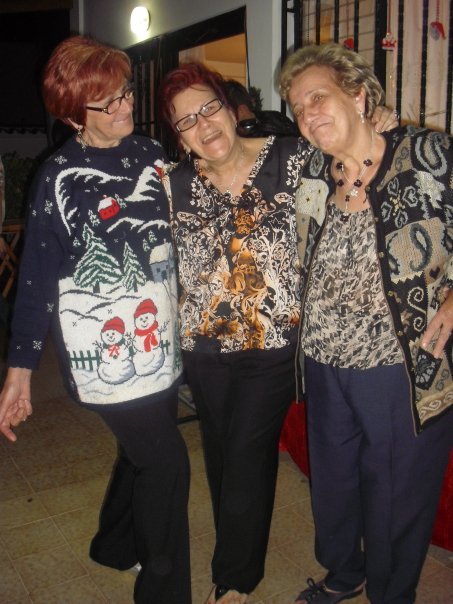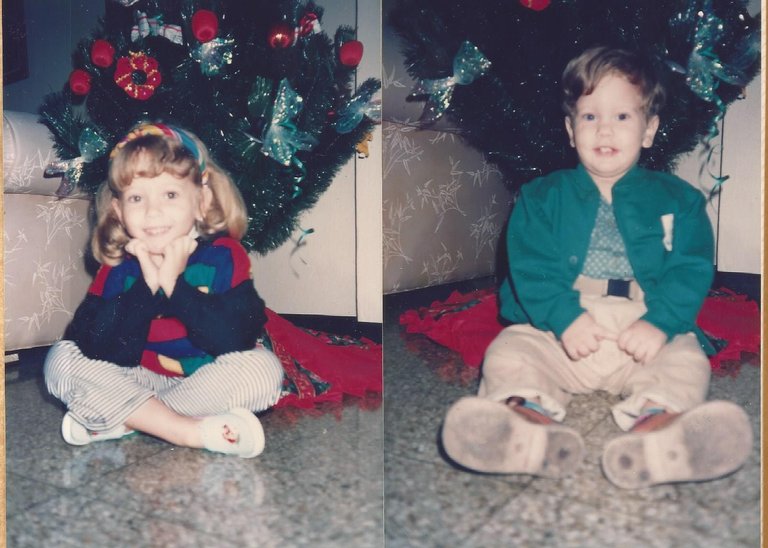The Christmas tree has been present year after year in my home, without knowing its origin or meaning. We have only known that it brings us together as a family to celebrate a tradition and also that it is a great, bright and beautiful ornament that makes us feel that Christmas has come to our home. In this post I will explain about the origin of this tradition, the meaning of the most common ornaments and also we will see some of the most interesting trees that have been exposed around the world.
.jpg)
Here I am with my mom and brother
The cult to the tree goes back to a very distant time. Pepe Rodriguez in his book “Mitos y ritos de la Navidad” (Myths and rites of Christmas) relates that between the third and second millennium BC in many places from Europe and Asia the oak was very important, as it played a fundamental role in agriculture and livestock. It was so important that it became the "Oak God". In places where the oak did not grow naturally, other trees of the area were venerated. In autumn when the leaves yellowed, it was believed that the spirit of the tree had left, so they decorated it to encourage their return ... and they succeeded 😆 because sooner or later spring would come..

The Oak
It is amazing how this tradition has continued decorating trees until reaching our generation. Instead of decorating an oak, today we decorate a pine tree that thanks to its evergreen leaves, it represents the immortality before the cold winter. It has also been endowed with religious meanings, like representing the holy trinity or the baby Jesus christmas tree.
The tree has other important meanings. In the center of the Garden of Eden, it was the majestic tree of life and wisdom. Jesus died crucified in the wood of a tree, saving us from the original sin. And also it was considered as a bridge between the sky, the earth and beyond, for its roots immersed in the earth, its trunk in the center and the branches that often seem to reach the sky.
The irony of this tradition is that, with the passage of time, instead of venerating and caring for trees, these are cut down at Christmas time to decorate the houses. If this ritual began by venerating the trees, it should never have happened to anyone, as it has unfortunately happened.
My grandparents on both mom's and dad's side are from the island of Madeira, located in Portugal. The tradition in my grandmother's house, as a child, was to look in the mountains for a pine tree and then take it home for decoration. I never had the opportunity to talk with my grandmother on my dad´s side, to confirm about his childhood tradition to look for a Christmas tree to decorate, but my father told me that in his childhood (living in Madeira), he always went on a journey to look for a pine tree with his brothers in the mountains, and if they did not find it, what they usually did was cutting an old tree, and decorated it with some moss. Both traditions were made just on Christmas Eve. After emigrating to Venezuela, as their economic possibilities changed, instead of looking for a tree, both families opted to buy artificial trees, except when my grandparents lived in the village of Boca de Uchire in Anzoátegui, at that time they usually decorated branches of nearby trees.

My grandmother and her sisters
During each season, the Christmas decorations have changed, but there are some common characteristics that are maintained through time, for example lights or spherical objects. On the branches of the oaks, colorful fabrics and painted stones were hung, acting as amulets to attract spring. In other eras, apples and other fruits were hung, candles were also placed nearby to light the tree. In my grandmother's house, on Madeira island, the ornaments were balloons and lights with big light bulbs in the form of scenes and Christmas angels bought at Chinese stores. In my dad's house, since they did not have the economic condition to buy ornaments, they made them with objects that they found. Sometimes they used rubber balls or a plant that he calls "cabritas". In our most recent tradition, the ornaments are Christmas balls, teddy bears, lights, Christmas flowers, bows, among others... Many ornaments without ever asking us the meaning they possess …
St. Boniface, evangelizer of Germany, decorated a pine with just apples and candles, the apples represented the original sin and temptations; the candles represented the light of Christ in the world. Over time, other fruits were added representing the graces and gifts that man had when he lived in Paradise. These spherical fruits gradually became behind the scenes, balloons in the case of my grandmother, or rubber balls in the case of my father. At the top of the tree we usually place a star or an angel. The star represents the guide that took the Magi to the birthplace of the baby Jesus, today symbolizes the faith that should guide the lives of Christians. The angel represents the envoy of God as guardian of his legacy and protector of men. Before the tradition of the tree was adopted by Christianity, the stars and balls signified the stars and celestial bodies of the universe. Finally, the ties, a very common adornment, represents the family union.

For some populations, the Christmas tree has become so important that the people seeks to have the most special in the world, for example, the highest one, the most expensive or the most original. On Christmas 2012, a pure gold japanese tree, rotating with all the Disney characters, went on sale. The price of one little tree with only 20 Disney characters, measuring 25 cm costed about 189,000 euros, and of course it found several buyers. Another interesting example is a Christmas tree made with bicycles displayed in the Tczew Square of Poland. Its lights are lit by generating energy with one of the bicycles. In Rio de Janeiro, the largest floating tree in the world has been installed. The largest Christmas tree is located in Italy, with 650 meters high, lighting up Mount Ignio. A final and very particular example is a tree made entirely with blocks of Lego, located in a Legoland park in Malaysia, It taked more than 400,000 bricks to build it.

Disney japanese tree
What I like the most about Christmas trees is the tradition of bringing us together as a family. In my home, although my father preferred to set up the tree on Christmas Eve, we always set it up several weeks before, with Christmas carols and ‘gaitas’ (Venezuelan traditional christmas music); with all the members of the family. Today, since my parents are separated, that tradition has been losing, so the magic of the Christmas tree is no longer exciting. In addition, as we have been growing up and with more and more things in the house, the space has been reduced, reaching the point of dwarfing the tree and with not so much decoration. However, we will always have a tree, even a smaller one, because this tradition has been marked almost genetically in our soul.
This text was translated from my post: https://steemit.com/spanish/@jenniferdosreis/origen-del-arbol-de-navidad-y-tradicion-en-mi-familia
%20(1).jpg)
My brother and I with the Christmas tree
The Lego tree